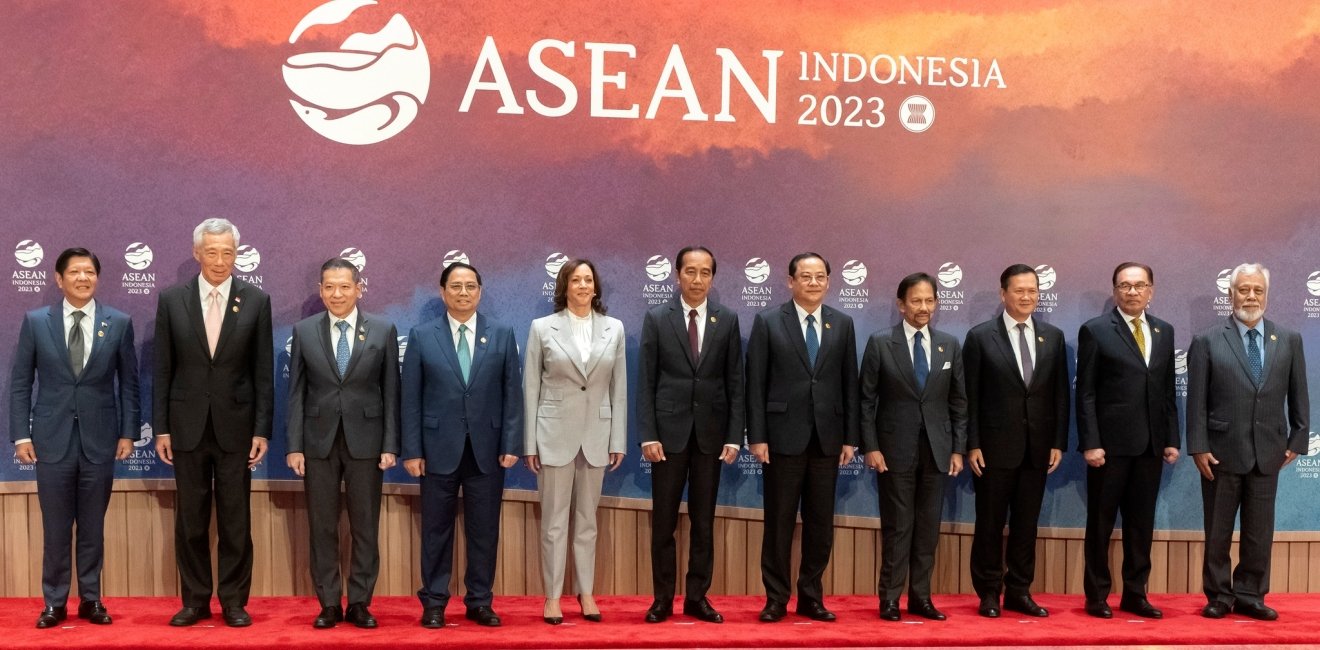The Waves Rocking ASEAN’s Ship
Following ASEAN's 2023 Summit in Jakarta, Indonesia, the Southeast Asian bloc faces a series of challenging headwinds.

A blog of the Indo-Pacific Program
Following ASEAN's 2023 Summit in Jakarta, Indonesia, the Southeast Asian bloc faces a series of challenging headwinds.

This past week, the Association of Southeast Asian Nations (ASEAN) convened for its annual Summit and associated regional diplomatic fora, including the East Asia Summit (EAS). Chaired this year by Indonesia, President Joko Widodo (known as Jokowi) gave remarks warning against ASEAN being torn apart by its many internal divisions and the looming threat of great power competition. Recalling the importance that ASEAN places upon its central role in the region’s diplomacy, Jokowi called upon partners to “not make our ship, ASEAN, an arena of rivalry that destroys each other, but make this ASEAN ship, a field to foster cooperation to create prosperity, create stability, create peace, not only for the region but also for the world.” Yet, despite several decades of promising economic growth and regional integration, ASEAN faces three intractable challenges that threaten to swamp its metaphorical boat.
First, great power rivalry between the United States and China concerns all ten Southeast Asian states, who remember the human toll that the Cold War brought to the region. As Washington and Beijing increasingly jockey for influence in Southeast Asia, President Jokowi’s elaborated on his hope that the ASEAN-Indo-Pacific Forum “will transform rivalry in the Indo-Pacific region into mutually beneficial cooperation.” At the EAS, Jokowi reiterated that “we all have a responsibility to not create new conflict, new tension, new war at as the same time we also have a responsibility to reduce tensions.”
However, China and the United States appear increasingly locked into prolonged competition beyond ASEAN’s capacities to manage. With neither President Joe Biden or President Xi Jinping attending in person, the 2023 Summit provided few outlets for great power rapprochement.
Second, China continues to harass the other claimants in the South China Sea as ASEAN idles, hamstrung into inaction. Following an August 2023 water cannon incident during which a Chinese Coast Guard vessel harassed a Philippine ship attempting to resupply forces on Second Thomas Shoal and China’s publication of a provocative new map, Philippine President Ferdinand Marcos Jr. announced his intent to advocate for a joint ASEAN statement on the South China Sea.
Yet, it appears that Manila opted to pass, perhaps seeing it as hopeless. Indeed, ASEAN has struggled for years to make progress on a Code of Conduct in the South China Sea to no avail, and Cambodia in particular has blocked language critical of China several times in the past ten years. Despite five ASEAN member states—Malaysia, Indonesia, the Philippines, and Vietnam—protesting China’s claims for its most recent map, the 2023 Summit declined to issue a bloc-wide statement calling out Beijing. As demonstrated by the recent upswing in US-Philippine relations, Manila likely sees its alliance with Washington as the only real means of protecting itself.
Third, the February 2021 coup d’état and subsequent renewed civil war in Myanmar continues to escalate in violence while ASEAN’s member states argue over how to respond. After initially agreeing to a Five-Point Consensus in 2021 as a roadmap to negotiations, the grouping has remained hopelessly divided between the more democratic maritime states and the more authoritarian mainland countries ever since.
Despite Indonesia’s efforts to pursue backdoor diplomacy, the recently departed Thai military-dominated government upended ASEAN’s approach by re-engaging the junta in Myanmar, as have China and India. Some small progress could be seen in this year’s Summit, including the establishment of a troika model, blocking the Myanmar junta from assuming the Chair in 2026, and mildly critical language calling out “the Myanmar Armed Forces in particular…to de-escalate violence,” but it is too little, too late. In Myanmar’s third year of renewed civil war, the pro-democracy resistance have steadily weakened the military regime in spite of ASEAN’s inability to hold the junta to account for its crimes.
Facing headwinds of great power competition, China’s assertiveness, and Myanmar’s civil war that it is institutionally poorly suited to addressing, ASEAN may find itself barely staying afloat as these crises continue.
Facing headwinds of great power competition, China’s assertiveness, and Myanmar’s civil war that it is institutionally poorly suited to addressing, ASEAN may find itself barely staying afloat as these crises continue. ASEAN’s norms of non-interference and consensus mean that internal political divisions can derail bloc-wide action on all three problems. For instance, Cambodia, which often acts as a pro-Beijing spoiler, vetoed Indonesia’s 2023 proposal to hold an ASEAN naval drill near the South China Sea, forcing Indonesia to move the exercise to a less controversial location.
Still, many in Southeast Asia view ASEAN as largely responsible for the region’s economic success and peace. As former Singaporean diplomat Kishore Mahbubani argues: “[Growth and peace in Asia] is largely due to ASEAN, which despite its many flaws as a political and economic union has helped forge a cooperative regional order built on a culture of pragmatism and accommodation.” Jokowi branded this year’s theme as “ASEAN Matters: Epicentrum of Growth” to underscore “ASEAN’s commitment to ensure its continued relevance, resilience, effectiveness, and responsiveness to future regional and global challenges, and its vision to be the center and driver of economic growth in the region and beyond.” This is a lofty goal for the multilateral organization, one that reflects ASEAN’s genuine post-cold war success in bringing together a previously divided—and often warring—region.
However, the ASEAN 2023 Summit unfortunately demonstrates that ASEAN is facing a changed Indo-Pacific landscape vastly different than the post-Cold War moment and a series of truly sharp internal divisions that it may be unable to overcome. Throughout its year-long tenure as Chair, Indonesia fought uphill against this trend, attempting to make progress on the South China Sea Code of Conduct negotiations and the Myanmar crisis, but without many concrete gains. Laos will now take over the Chair role for 2024, with significantly less appetite or capacity to manage great power tensions, much less take a stand on China and the junta in Myanmar.
We are already seeing the consequences of the bloc’s indecision not only in Myanmar and the South China Sea but also to its own institutional credibility. Timor Leste, which plans to accede to ASEAN, has expressed its dissatisfaction with ASEAN’s inability to address the Myanmar coup, even threatening to potentially withdraw its decision to join the bloc. If ASEAN cannot find some way forward or reform to adapt to these changing times and challenges, the ASEAN ship will continue taking on water without a means of bailing it out.
The views expressed are the author's alone, and do not represent the views of the U.S. Government or the Wilson Center. Copyright 2020, Asia Program. All rights reserved.


The Indo-Pacific Program promotes policy debate and intellectual discussions on US interests in the Asia-Pacific as well as political, economic, security, and social issues relating to the world’s most populous and economically dynamic region. Read more
